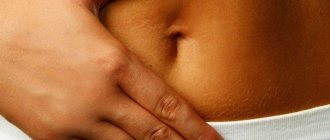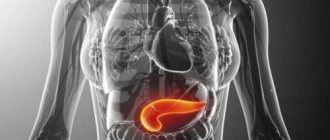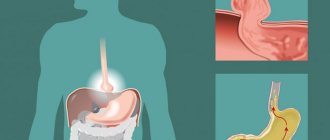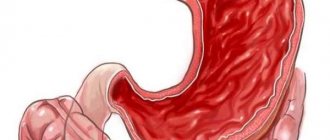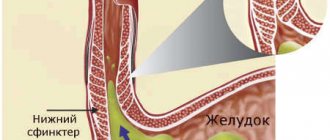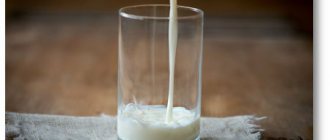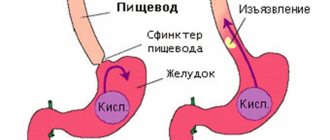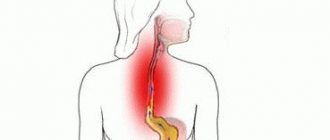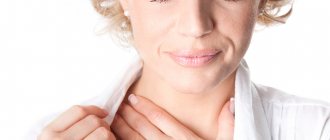Causes of reflux esophagitis
Often this disease occurs due to weakening of the muscle tone of the lower esophageal sphincter. As a result, the latter is partially or completely open, allowing the contents of the stomach to enter the esophagus.
In turn, sphincter insufficiency occurs due to nervous stress, chemical/nutritional factors, and increased pressure in the peritoneum.
A hiatal hernia can provoke sphincter insufficiency: when the latter expands, reflux of the stomach contents occurs.
Provoking factors:
- Obesity;
- Smoking, alcoholism;
- Taking a number of medications (eg nitroglycerin, metoprolol);
- Excessive passion for coffee, chocolate, spices;
- Pregnancy;
- Peptic ulcer disease.
Complications
In most cases, patients who are subsequently diagnosed with GERD seek help untimely, when the disease is already in a fairly advanced state. This is explained by the fact that the symptoms of reflux esophagitis are not always pronounced, or the disease occurs completely against the background of their absence. It is necessary to consult a doctor even if there are minor complaints, for example, pain or a lump felt when making swallowing movements. Otherwise, the disease can provoke a number of the following complications:
- Deterioration of general condition, decreased immunity, headache, physical weakness, anemia - a number of these symptoms can be caused by a decrease in the amount of substances absorbed from food, which is associated with the presence of pathologies in the digestive organs.
- Pathologies of esophageal tissues, expressed in their degeneration. This condition is a precancerous stage.
- Ulcers, scars, erosions, the appearance of which is due to systematic damage to the mucous membranes. In especially severe cases, perforation of the walls of internal organs may occur, which entails very serious consequences.
- The development of diseases of the nasopharynx and respiratory organs. These can be diseases such as laryngitis, tracheitis, bronchitis and many others.
A complication of reflux esophagitis can be in the form of laryngitis
Degrees and forms of the disease
This pathology can occur acutely and chronically. In the first case, symptoms include pain after a meal, discomfort behind the sternum along the esophagus, general malaise, a slight increase in temperature, a burning sensation in the neck, and excessive salivation.
The chronic form of inflammation manifests itself primarily in pain localized behind the sternum, often accompanied by gastritis. Heartburn, difficulty breathing, hiccups, and vomiting occur.
What is it - reflux esophagitis of 1, 2, 3 and 4 degrees?
- The first degree indicates that there are several erosions on the mucosa that do not merge, as well as erythema in the distal part of the organ;
- Second degree - erosions are already merging, but do not affect the entire mucous membrane.
- Third, ulcerative lesions form in the lower third of the esophagus.
- The fourth degree is chronic ulcer and stenosis.
Prevention
The simplest measures to prevent gastroesophageal reflux disease, esophagitis and the symptoms caused by them are:
- Timely treatment of somatic diseases.
- Refusal of alcoholic drinks and cigarettes. If you are bothered by a cough due to GERD and symptoms such as heartburn and belching, then it is better not to inhale tobacco smoke. Passive smoking is no less harmful.
- Proper nutrition (limiting foods that enhance fermentation in the menu, avoiding carbonated water and chewing gum, dividing the daily diet into 4-5 meals, observing intervals between meals of 3-3.5 hours, avoiding eating before bed, and avoiding fried foods ).
- Prevention of burns of the esophagus and stomach.
- Elimination of stressful situations.
- Elimination of exposure to adverse occupational factors.
- Refusal from uncontrolled use of medications.
- Prevention of injury.
- Maintaining optimal weight.
- Dosing of physical activity.
- Regular visits to a gastroenterologist.
- Fighting Helicobacter pylori infection (these microbes can cause ulcers and gastritis, increasing stomach acidity).
In order to prevent exacerbations of the disease, sanatorium-resort treatment is useful. Specific prevention of GERD in children and adults has not been developed.
Symptoms and treatment strategy for reflux esophagitis
The first warning sign is heartburn. The latter can occur regardless of the time of day, after eating, or when the body is in a horizontal position.
In addition, pain occurs in the chest area, which is often perceived as cardiac pain. Sometimes the listed symptoms are completely absent, but there is a violation of the swallowing process. The latter indicates the development of cicatricial narrowing and the progression of pathology.
Other symptoms of the disease:
- Sour or belching air;
- Failures in the swallowing reflex, disruption of food passage;
- Chronic cough, blockage of the bronchi with viscous secretions;
- Rhinitis and pharyngitis. The mucous membrane of the pharynx and nose becomes inflamed due to frequent contact with the contents of the stomach;
- Destruction of tooth enamel by acidic gastric juice.
Sometimes even an experienced doctor finds it difficult to identify this disease, since it has a similar clinical picture to many gastrointestinal pathologies.
In order to detect the disease in a timely manner, it is necessary to conduct a number of studies. Typically, a set of diagnostic procedures includes esophagoscopy (examination of the esophagus using endoscopic equipment), X-rays, biopsy of the mucous membrane, esophageal pH-metry (to determine the level of acidity).
How to treat reflux echophagitis with folk remedies at home?
The danger of esophagitis is the asymptomatic nature of the first stages, when the disease is easier to cure. With constant exposure to digestive juice thrown back into the esophagus due to reflux, severe irritation of the walls of the esophagus occurs with damage to the mucous membrane. As a result, unpleasant symptoms appear in the form of heartburn, belching, burning pain and other manifestations. Many of them are easily eliminated with folk remedies.
But before starting treatment, you should consult your doctor. Only a specialist can create a suitable therapeutic course that will not cause harm. In addition to using non-traditional recipes, the patient will be required to:
- lifestyle change;
- improving the quality of nutrition;
- taking certain medications.
The treatment regimen using alternative medicine methods is based on the simultaneous use of two approaches:
- optimal selection of medicinal nutrition products;
- treatment with herbal recipes.
Before the patient begins treatment according to traditional prescriptions, he must undergo a consultation with the attending physician, who will prescribe the appropriate medications. They are used in conjunction with folk recipes, which are mainly intended to protect the mucous parts of the esophagus and can neutralize the effect of hydrochloric acid secreted by the stomach.
To combat the disease with herbs, you can use the so-called medicinal mixture. It is prepared from equal quantities of the following plants:
- Common anise - fruit.
- White lily.
- Calendula - flowers.
- Snake knotweed - roots.
- Melissa - leaves.
- Narrow-leaved fireweed.
- Oregano is a herb.
All this is crushed and mixed. Then take two tablespoons of this mixture, pour it into a thermos and fill it with 2 glasses of boiled water. It is necessary to insist for three hours. The resulting broth should be filtered. Take the medicine every 1.5 hours, fifty milliliters for 12 hours.
Another folk recipe suggests using yellow dandelion flowers. To prepare the product, you need to completely fill a three-liter vessel (jar) with it. The flowers should be washed well, crushed and covered with sugar. For this you will need half a kilo of granulated sugar. Soon there will be a release of juice, which must be collected. It is recommended to take this liquid one teaspoon after diluting the juice with water (1/2 cup). This remedy should be drunk every day before meals.
Another recipe suggests that patients be treated with a collection of herbs such as:
- Motherwort, licorice, plantain, lemon balm - a tablespoon each.
- Flax - seeds, chamomile - flowers, two tbsp. spoons.
All these components are thoroughly mixed and crushed. Then take 2 tablespoons of this mixture and pour two glasses of boiled water. Boil for ¼ hour in a water bath, leave for two hours, filter. The course of treatment is ½ glass four times a day before meals.
Celery is a good remedy to combat reflux. Juice is made from its roots, which should be drunk on an empty stomach, one tablespoon at a time, ½ hour before eating. This medicine stimulates the blood well.
You can also use regular potatoes for treatment. There are two recipes for this. The first involves the use of a raw product, from which the juice is squeezed or the root of which is cut into small slices and consumed an hour before meals. The second method of using potatoes is as follows:
- Five roots are cut into several pieces.
- They are boiled with the peel. To do this, water must be taken in a 1:2 ratio.
- After boiling, cooking should be continued for 1 hour, while constantly monitoring the amount of water, adding it as needed.
- The broth is cooled and taken ½ hour before meals.
DETAILS: Intervertebral hernia of the lumbar spine: symptoms and treatment. How to treat intervertebral hernia in the lumbosacral region? Why is a herniated disc in the lower back dangerous?
Another collection of herbs to combat reflux:
- Wormwood, mint - two small spoons each.
- Chopped chamomile - one teaspoon.
Mix everything and pour one liter of boiling water on top. The infusion must be continued for at least 2 hours, and then strain the resulting broth through cheesecloth. Take ½ glass 30 minutes before meals.
Since esophagitis can cause severe inflammation, traditional medicine offers a way to eliminate them. To do this, use dill tincture. Take two teaspoons of the seeds of this plant and finely pound in a mortar. Then the resulting powder is poured with boiling water (1 cup). The resulting mixture is covered with a saucer and left for 120-180 minutes. Then it must be strained using gauze. The decoction is taken every 6 hours, one tablespoon.
An excellent remedy for reflux is Jerusalem artichoke. This plant is good to use not only for this disease - it can also be useful for other diseases of the gastrointestinal tract. To use it, you need to grate one green fruit and tubers (several pieces) of an earthen pear. Everything is thoroughly mixed and eaten immediately. This should be done twice a day. This medicine is good for relieving heartburn due to esophagitis.
To combat the disease at home, you can use a remedy such as wheat grain. It is washed in boiling water and taken in this form 2 times a day. If you don’t like this method, you can add grains to the soup or make porridge from them.
When turning to one or another method of treating reflux, it is important to timely and accurately diagnose the disease and strictly follow all the instructions of the attending physician. Traditional methods of combating this disease can be used to speed up the course of therapy.
It just so happens in our time that the best doctor is a friend in misfortune or a close relative with a similar disease. Any treatment must be approached wisely, trying to understand the need to take these particular remedies.
Today we’ll look at the most frequently recommended recipes and whether you should believe such advice.
Esophagitis must be treated taking into account the etiology, pathogenesis and symptoms of the disease.
When symptoms of reflux esophagitis appear, treatment consists of eliminating the disease that caused it (gastritis, neurosis, peptic ulcer or gastroduodenitis). Proper therapy will make the symptoms of reflux in adults less pronounced, help reduce the harmful effects of gastric contents thrown into the esophagus, increase the resistance of the esophageal mucosa and quickly clear the stomach after eating.
Conservative treatment is indicated for patients with an uncomplicated course of the disease. It includes general recommendations:
- after eating, avoid bending forward and do not lie down for 1.5 hours
- sleep with the head of the bed raised at least 15 cm,
- do not wear tight clothes and tight belts,
- limit the consumption of foods that have an aggressive effect on the mucous membrane of the esophagus (fats, alcohol, coffee, chocolate, citrus fruits, etc.),
- quit smoking.
Drug therapy for reflux esophagitis is carried out for at least 8-12 weeks, followed by maintenance therapy for 6-12 months. Prescribed:
- proton pump inhibitors (omeprazole, lansoprazole, rabeprazole) in regular or double dosage,
- antacids (Almagel, phosphalugel, Maalox, Gelusil-lac, etc.) are usually prescribed 1.5-2 hours after meals and at night,
- prokinetics – domperidone, metoclopramide.
To reduce the manifestation of such symptoms as heartburn and chest pain in a lying position, you should take the correct position - the upper part of the body should be slightly elevated, for which you can use several pillows.
If you decide to treat reflux esophagitis with folk remedies, it is very important to follow all the recommendations of herbalists. You must understand that positive results will not come immediately, but after some time. Also follow the recommendations for proper nutrition and lead a healthy lifestyle.
What is catarrhal and erosive reflux esophagitis?
The catarrhal form of the disease is most often diagnosed. In addition to the main symptoms listed above, the doctor, during a diagnostic study, detects swelling and hyperemia of the esophageal mucosa. Catarrhal esophagitis occurs due to insufficient function of the cardiac sphincter of the esophagus.
Erosive reflux esophagitis is characterized by stronger and deeper damage to the mucous membrane. This form of pathology is less common than the previous one, but much more often leads to various complications. Thus, the disease is accompanied by the formation of ulcers and erosions on the mucous membrane of the esophagus.
There are 3 degrees of pathology:
- I – single formation of small erosions;
- II – increase in the affected area;
- III – formation of a chronic ulcer.
Treatment for children
In severe cases, cough therapy for reflux esophagitis is carried out using medications intended for adults. An individual dosage and treatment period are selected. Medicines for young children are produced mainly in the form of suspensions with a pleasant taste. In most cases, to treat children from reflux esophagitis and cough, a strict diet is prescribed for 14-30 days with further adherence to nutritional rules and lifestyle.
Exclude:
- Carbonated drinks;
- Chocolate;
- Beer;
- Candies;
- Sweets with a lot of cream;
- Ice cream;
- Marmalade;
- Candies;
- Cocoa;
- Coffee;
- Hard cheese, processed;
- Spices;
- Spicy, fatty, salty dishes;
- Mayonnaise;
- Ketchup;
- Honey;
- Cabbage;
- Legumes;
- Apples;
- Citrus;
- Grape;
- Raspberries;
- Strawberries;
- Plums;
- Cherries;
- Apricot;
- Tomatoes;
- Pepper;
- Black bread;
- Fresh baked goods;
- Pasta;
- Fat meat;
- Corn.
Introduce into the diet:
- Milk;
- Cottage cheese;
- Kefir;
- Homemade yogurt;
- Dried fruits;
- Butter;
- Watermelon;
- Melon;
- Zucchini;
- Chicken, turkey meat;
- Fish;
- Eggs;
- Buckwheat;
- Rice;
- Oatmeal;
- Semolina;
- Banana;
- Sweet apple;
- Pear;
- Kissel;
- White bread;
- Cracker cookies;
- Drying;
- Straw;
- Bagels.
Avoid products with added chemical ingredients, semi-finished products, and fast foods. The daily diet should include porridge, soups, fermented milk products, vegetable puree, stew, still mineral water, tea based on medicinal herbs. Ensure normal psycho-emotional rest, rest, healthy sleep.
How to relieve symptoms and treatment of the disease, diet for reflux esophagitis?
As with any other diseases, therapy in this case begins with excluding possible causes of the pathology, for example:
- smoking;
- stress;
- obesity.
Medications are mandatory.
- First of all, these are antacids - drugs that reduce the acidity of gastric juice by neutralizing it. One of the most famous antacids is Almagel. The latter is taken for several days in a row, 5-10 mg three times a day before meals.
- In addition to antacids, treatment includes prokinetics - substances that increase muscle tone of the lower sphincter. These include “Motilium” and “Motilak”.
- It is also necessary to take antisecretory drugs that reduce acidity by inhibiting the production of the latter. These include Famotidine and Omeprazole.
Clinical picture
The clinical picture of the disease is diverse and versatile, and also largely depends on the physiological characteristics and general well-being of the patient. Unpleasant symptoms characteristic of a disease such as reflux esophagitis or GERD can be either constant or occur periodically.
In many ways, the severity of the manifestation of signs of the disease depends on the stage of development of reflux esophagitis, namely, on the degree of damage to the mucous tissue of the esophagus. For example, in the presence of minimal pathologies, symptoms may be minor or absent altogether. However, as the disease progresses, they take on a more acute form.
In addition, the main signs of GERD are most clearly manifested when a person takes a certain position, in most cases horizontal, or when consuming large amounts of food or overly spicy foods.
One of the symptoms of GERD is heartburn.
Among the most pronounced symptoms of a disease such as reflux esophagitis, the following can be named, which, in fact, somewhat distinguish this particular type of disease from the general category of pathologies called GERD:
- An unpleasant sensation, especially after eating food, characterized as a lump in the throat. It should be noted that such a symptom, that is, a lump, can accompany not only physical pathologies, but also some mental disorders. In such cases, the intervention of a psychologist is necessary. If a lump occurs due to reflux esophagitis, adjustments to the diet are necessary.
- Periodically occurring heartburn, which increases significantly when the patient takes a horizontal position, as well as when eating excessively spicy, salty, or other types of food that irritate the mucous tissues of the stomach and esophagus quite strongly.
- Pain, burning sensation in the upper chest. This sign, as well as a lump in the throat, as well as heartburn, indicates irritation of the mucous tissues of the esophagus. In some cases, sensations of this kind are mistakenly confused with signs of other diseases.
- Quick satiety with a small amount of food, a feeling as if there is a lump in the throat, as well as pain after eating or directly when swallowing. Such symptoms may indicate quite serious damage to the mucous tissues.
The appearance of a lump in the throat indicates developing reflux esophagitis
Diet for reflux esophagitis
Diet correction is a mandatory component of the treatment complex. First of all, you need to exclude the following products from the menu:
- alcohol (increases acidity, relaxes the sphincter);
- strong tea, coffee, soda;
- chocolate (promotes relaxation);
- mushrooms;
- mayonnaise, ketchup, hot seasonings;
- smoked meats;
- marinades;
- legumes, especially peas and beans (increase intra-abdominal pressure);
- canned food;
- sour juices;
- fresh and sauerkraut;
- fat;
- black bread;
- fast food, chips, chewing gum;
- fried foods.
If discomfort occurs after eating, you need to pay attention to what foods were eaten and, accordingly, exclude them from the diet.
The diet must include the following products:
- pureed cottage cheese (low fat);
- sour cream and milk (low fat);
- fresh and soft-boiled chicken and quail eggs;
- homemade crackers;
- any porridge;
- steam cutlets;
- baked sweet apples;
- baked vegetables;
- baked and boiled fish.
You can diversify your diet with foods that do not cause discomfort after consumption. In addition, you need to pay attention to your diet. It is necessary to avoid nervous overload at work, get good sleep, eat 4-5 times a day (eat slowly, avoid rushing), after a meal it is recommended to walk or work while standing (you cannot sit).
It is recommended to wear loose clothing that does not restrict movement in the abdominal area. In addition, you cannot strain the abdominal muscles, so lifting weights is also excluded.
Treatment with antacids
To successfully treat reflux disease, several basic requirements must be met:
- adherence to diet and nutrition;
- taking neutralizing agents;
- if symptoms are severe, first add proton pump inhibitors (STIs), histamine receptor blockers and prokinetics to the therapeutic regimen;
- severe cases require surgery.
The most expensive, multi-component and authoritative treatment will not give the desired results if you do not get rid of the cause that causes the pathological symptoms.
The first condition of any treatment regimen is the exclusion from the diet of sour, fried, pickled foods, as well as fatty, salty foods. The nutrition schedule should be streamlined, eat at short intervals, in small portions.
Oak bark decoction
To prepare the decoction, grind and mix the following ingredients:
- oak bark - 30 grams;
- washed walnut leaves - 40 g;
- St. John's wort - the same amount (they take both the grass and the flower);
- Oregano - 20 grams;
- Potentilla - 30 g.
After thorough mixing, take 30 grams of the resulting mixture into a container and pour 3 cups of boiling water. Before putting it on the stove, let the herb steep for 3 hours. Only then boil for 5 minutes, filter through a fine sieve and drink 50 ml 3 times a day, before or after meals, 15 minutes. The duration of treatment of reflux esophagitis with folk remedies including oak bark should not exceed two weeks. According to experts, if treated for longer, an overdose may occur, accompanied by nausea and vomiting.
Juice from plantain and celery leaves
Plant leaves are taken in equal proportions and passed through a juicer. The liquid turns out thick and concentrated - an excellent folk remedy in the treatment of reflux esophagitis. Now 1 tbsp. l. Dilute the resulting juice in a glass of boiled water (250 ml). Drink it 20 minutes before meals, 3-4 times a day, 100 ml.
You can also use a paste made from a mixture of plantain and celery leaves, minced through a meat grinder. Based on the reviews of patients, it is enough to eat 1 tbsp. l. means to obtain an effective result.
Symptoms
The first signs appear: general malaise and fever. A person is tormented by pain behind the sternum, throughout the esophagus. Additional symptoms of reflux esophagitis may include heartburn, vomiting, or hiccups.
Pathology can occur secretly. Sometimes esophagitis is accompanied by signs that are uncharacteristic of this disease. Each form has the same symptoms:
- lump in throat;
- heartburn;
- sour belching;
- burning or pain in the chest;
- nausea.
An hour and a half after eating, pain in the esophagus begins. This is already pronounced inflammation. Symptoms are worse when the person lies down. Signs of reflux esophagitis may vary depending on the stage and type of disease:
- Pulmonary is caused by heartburn and unpleasant belching. Obstruction of the bronchi appears - prolonged cough, nocturnal suffocating attacks, lack of air. This can trigger the formation of asthma.
- Cardinal is accompanied by symptoms inherent in angina pectoris due to the close proximity of nerve endings. Pain always occurs after sour or spicy foods, fried or fatty foods, or overeating.
- Otolaryngological , in addition to belching and heartburn, is accompanied by sore throat and sore throat. Nasal congestion and discharge in the form of clear mucus may appear.
- The dental form is accompanied by the appearance of caries. This is facilitated by gastric juice, which eats away tooth enamel.
Symptoms of subtypes of chronic reflux esophagitis
| Types of pathology | Symptoms |
| Catarrhal (aka superficial) | Difficulty swallowing food. After eating, a person begins to suffer from dull pain in the esophagus, belching mucus, and heartburn. While eating, a burning sensation and rawness increases behind the sternum. Pain can radiate to the neck, shoulder blades and jaw. Increased salivation appears. |
| Exfoliative | Constant pain between the shoulder blades, worsening when swallowing liquid or inhaling. General weakness, anemia, body temperature rises. When taking tests, a violation of the level of leukocytes is detected. |
| Hydropic | This form is a continuation of catarrhal. In addition to its inherent symptoms, swelling of the esophagus additionally occurs. |
| Erosive | Pain appears, “walking” along the entire length of the esophagus. Mainly during meals. There is a burning sensation in the chest, belching with blood appears and the remains of undigested food come out. The person experiences severe fatigue, fainting, and mild anemia. If an additional infection occurs, bleeding occurs and esophageal cancer may occur. |
| Pseudomembranous | Difficulty swallowing. During this process, the pain in the chest increases. A cough with blood appears. A sign of recovery is the release of pieces of fibrinous film into the oral cavity. |
| Necrotic | Intense pain, dysphagia, frequent vomiting, in which pieces of mucous are visible. In the complicated form, bleeding occurs. This can provoke the appearance of purulent mediastinitis and abscess. |
| Phlegmonous | Pain when swallowing food, fever, dysphagia. A disturbance in the level of leukocytes is detected. Pain occurs when you move your neck. The same sensations occur when palpating the abdominal muscles. A purulent abscess may begin. This is accompanied by vomiting with blood clots. The person shudders, sweats profusely and feels unbearable pain in the sternum. |
The hemorrhagic form is a type of acute esophagitis. Appears very rarely, against the background of severe erosive inflammation. Accompanied by bloody vomiting and melena (tarry stool).
Note! Without timely treatment of the disease, it can last for years. Over time, the symptoms will intensify, and eventually irreversible changes in the mucous membrane will occur and scars will appear on it.

